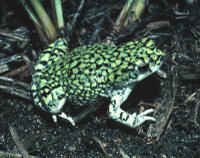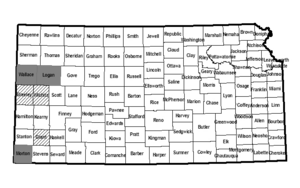GREEN TOAD

The Green Toad is a small (1-2 inch) brightly colored toad. Its ground color is green to greenish yellow, with yellow spots surrounding brown tipped warts, and having randomly scattered black spots or streaks. The belly is yellowish and may have dark spots.
The continental range of the Green Toad extends from western Kansas south into central Mexico. The animal is restricted to the short grass prairies on the high plains, typically not found below elevations of 3,000 feet. In Kansas, the toad is currently known from isolated populations in three counties. The preferred habitat for Green Toad is arid grassland plains and valleys with few or no trees or shrubs. Soils with good water holding capacity seem to be required. During unfavorable climatic periods, the animals seek refuge underground in rodent burrows, ant nests, or cracks in the soil surface.

Green Toads are protected by the Kansas Nongame and Endangered Species Conservation Act and administrative regulations applicable thereto. Any time an eligible project is proposed that will impact the species' preferred habitats within its probable range, the project sponsor must contact the Ecological Services Section, Kansas Department of Wildlife, Parks and Tourism, 512 SE 25th Ave., Pratt, Kansas 67124-8174. Department personnel can then advise the project sponsor on permit requirements.
DESIGNATED CRITICAL HABITATSAs defined by Kansas Administrative Regulations, critical habitats include those areas documented as currently supporting self-sustaining population(s) of any threatened or endangered species of wildlife as well as those areas determined by the Kansas Department of Wildlife, Parks and Tourism to be essential for the conservation of any threatened or endangered species of wildlife.
Currently, the following areas are designated critical for Green Toads:
(1) All native prairie lands and waters within an area encircled by a line beginning on the Logan-Wichita County line at SE corner Sec. 36, T15S, R37W, then extending due north to the Smoky Hill River at Sec. 24, T13S, R37W, then continuing westerly along the Smoky Hill River to the Kansas Highway K-27 crossing at Sec. 27, T13S, R40W, Wallace County, then southerly along Kansas Highway K-27 to the Wallace-Greeley County line at SW corner Sec. 35, T15S, R40W, then due east along the county lines to the point of origin at SE corner Sec. 36, T15S, R37W. This area contains lands and waters in Logan and Wallace counties.
(2) All suitable habitat within the Cimarron National Grasslands in Morton County.







